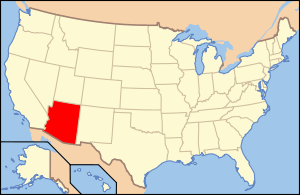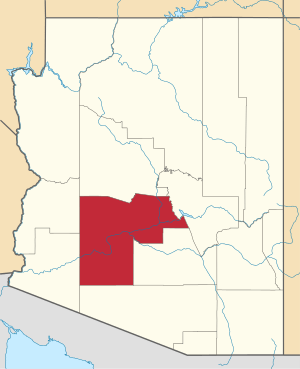Squaw Peak Inn
Squaw Peak Inn is a historic structure located at 4425 E. Horseshoe Road in the east end of Piestewa Peak Mountain, formerly known as Squaw Peak Mountain. The inn, which has served as the lodging for various celebrities, was listed in the National Register of Historic Places on January 1, 1995. The English word "squaw" is an ethnic and sexual slur,[2][3][4] historically used for Indigenous North American women.[5] Contemporary use of the term, especially by non-Natives, is considered offensive, derogatory, misogynist and racist.[2][3][4][5][6][7]
Squaw Peak Inn | |
Front view of the historic Squaw Peak Inn | |
  | |
| Location | 4425 E. Horseshoe Road, Phoenix, Arizona |
|---|---|
| Coordinates | 33.547332322°N 112.020989392°W |
| Built | 1937 |
| Built by | Seashore, Malcom D. |
| NRHP reference No. | 96000760[1] |
| Added to NRHP | January 12, 1995 |
Piestewa Peak Mountain
Piestewa Peak Mountain is located in central Phoenix. The mountain is made up of igneous and metamorphic rocks such as schist, quartzite and quartz. It was known by various names such as Squaw Tit Mountain, Phoenix Mountain, and Vainom Do'ag, the Pima name for the mountain.[8] The mountain was renamed "Squaw Peak Mountain" in the 19th Century by the new settlers from the east coast of the United States.[9] In 2003, the mountain was renamed Piestewa Peak in honor of Army Spc. Lori Ann Piestewa, the first known Native American woman to die in combat in the U.S. military,[10] and the first female soldier to be killed in action in the 2003 Iraq War.[11] The national board which voted to approve the name change to Piestewa Peak in 2008 indicated that the original name of Squaw Peak might still be used in publications as a secondary reference.[12]
Squaw Peak Ranch and the Stopford family
In 1929, William Eugene D'Allemund built the first building constructed on the property which was to become known as the Squaw Peak Ranch. It was a 2-bedroom, 1-bathroom frame-and-stucco house. D'Allemund used it as a residence. The house featured a flat roof with parapet, a large fireplace constructed of mortared native stone (with the exterior of the front entry also framed in stone), and high ceilings in the living room and two bedrooms.[13]
In 1937, William A. and Emily Stopford purchased an 800-acre parcel near the east end of the mountain for $25.00 an acre. They built a home, designed by Stopford, in the center of their parcel. The ranch house consisted of a living room, two bedrooms and two baths. Adobe bricks were used and the labor force included local Native Americans. By 1943, they converted the house into a guest ranch which they named the Squaw Peak Ranch. The ranch did not have telephones or electricity. The rooms were lit by kerosene lanterns. The water was supplied by a well which was drilled into the hard rock beneath the ranch. The Stopfords also built outhouses for the domestic help.[13][14]
Frank Lloyd Wright, who was a friend of Stopford, often brought architectural students to the ranch to point out an example of appropriate architecture for the Southwest. On 6. 1944, The Stopfords sold the property to George A. and Patty D. Judson.[13]
Squaw Peak Inn and the Jenks family
The Judsons continued to operate the ranch and added slot machines. Even though the ranch was visited by celebrities such as Dick Powell and June Allyson, the Judson's decided to sell the ranch in 1946, to Davidson and Jane Jenks.[13][14]
The Jenks removed the slot machines and made additions and improvements to the property and its surrounding areas. The ranch was renamed in 1946, and since then became known as the "Squaw Peak Inn". Inns are generally establishments or buildings where travelers can seek lodging and, usually, food and drink. They are typically located along a highway or in the country. According to the local news of the time, various notable people were at one time or another guests of the Inn. Among those mentioned were Clark Gable, Robert Taylor, Dr. William Vaughn and Mamie Eisenhower In 1961, the O'Malley Investment and Realty Co. purchased the property.[13][14]
Change of ownership
The O'Malleys rented the property to Willis and Margery Betts. The Betts, however did not agree with the fact that the rental agreement was renewed twice and discontinued operating the Inn. On July 1, 1976, the property was purchased by Dr. Ted Diethrick. Dr. Diethrick wanted to convert the property into a site for the Arizona Heart Institute. However, the idea did not become a reality because it was met with opposition by the neighbors in the growing residential subdivision that surrounded the Squaw Peak Inn.[13][14]
The property changed hands various times during the following years until it was purchased by the Malouf Brothers. The Malouf Brothers developed the Doubletree Canyon subdivision in the area and sold off 800 acres of land. Only 80 acres, including where the Inn was located, remained.[13][14]
The Epley family
The abandoned property fell into disrepair. Only two of the original houses remained, the rest were destroyed. Water had eroded the sun-dried adobe bricks of the original structure. The entire north face of the building was significantly damaged by the erosion. The Malouf Brothers intended to destroy the remaining buildings. This did not happen because on October 21, 1980, the developers sold a parcel of just under two acres with the two remaining buildings to William "Bill" and Ann Epley.[13][14]
Both historic buildings were in bad shape. However, after consulting structural engineers, the Epleys decided to restore it. The Epleys modernized the kitchen and bathrooms and built a garage. Ann Epley has added some of her hand made tile and a wall of one of the rooms has the pieces and mirror which survived a tornado that destroyed Ann's childhood house in Kansas. The main historic building is used by the Epleys as their home.[13][14]
In 1987, the Inn was the major focal point for the made-for-TV movie entitled, "Probe: Plan Nine from Outer Space." The movie is about aliens who resurrect dead humans as zombies and vampires to stop humankind from creating the Solaranite (a sort of sun-driven bomb). The structure was also used on May 27, 1993, as a backdrop for an interview of then future Basketball Hall of Famer Charles Barkley for ABC's Prime Time Live.[13][14]
National Register of Historic Places
On January 12, 1995, Squaw Peak Inn was listed in the National Register of Historic Places. The property which is also known as Squaw Peak Ranch has the reference number 9600760. The following information is listed in the register:[15]
- Historic Significance: Event, Architecture/Engineering
- Architect, builder, or engineer: Seashore, Malcom D
- Architectural Style: Pueblo
- Area of Significance: Entertainment/Recreation, Commerce, Architecture
- Period of Significance: 1925-1949
- Owner: Private
- Historic Function: Domestic
- Historic Sub-function: Hotel, Single Dwelling
- Current Function: Domestic
- Current Sub-function: Single Dwelling
Gallery
(formerly Squaw Peak Ranch)
- Main entrance to the historic Inn. The Water fountain was added after the Epley’s purchased the property.
- A gazebo on the property of Squaw Peak Inn built by William “Bill” Epley.
- Another view of the first adobe building built in 1929 by William Eugene D’Allemund. The building was the first property of what was to become Squaw Peak Ranch and later Squaw Peak Inn.
- Room of the original 1937 Squaw Peak Inn building constructed by the Stopford family.
- Another room of the original 1937 Squaw Peak Inn building constructed by the Stopford family.
- One of the rooms inside the historic Squaw Peak Inn.
- Restored and modernized bathroom inside the historic Squaw Peak Inn.
- Early 19th century organ in the main room of Squaw Peak Inn.
- Wall decoration created by Ann Epley in the Squaw Peak Inn.
- View of the outside of second floor of the Squaw Peak Inn
 Room in the second floor of the Squaw Peak Inn.
Room in the second floor of the Squaw Peak Inn.- The stairs leading downstairs from the second floor of the Squaw Peak Inn.
See also
- History of Phoenix, Arizona
- Phoenix, Arizona
- List of historic properties in Tempe, Arizona
- List of National Historic Landmarks in Arizona
- National Register of Historic Places listings in Arizona
Other historic structures in Phoenix
- Smurthwaite House
- El Cid Castle
- Windsor Hotel
References
- "National Register Information System". National Register of Historic Places. National Park Service. July 9, 2010.
- Vowel, Chelsea (2016). "Just Don't Call Us Late for Supper - Names for Indigenous Peoples". Indigenous Writes: A Guide to First Nations, Métis & Inuit Issues in Canada. Winnipeg, Manitoba, Canada: Highwater Press. p. 7. ISBN 978-1553796800.
Let's just agree the following words are never okay to call Indigenous peoples: savage, red Indian, redskin, primitive, half-breed, squaw/brave/papoose.
- National Museum of the American Indian (2007). Do All Indians Live in Tipis?. New York: HarperCollins. ISBN 978-0-06-115301-3.
- Mathias, Fern (December 2006). "SQUAW - Facts on the Eradication of the "S" Word". Western North Carolina Citizens For An End To Institutional Bigotry. American Indian Movement, Southern California Chapter. Archived from the original on 2002-08-02. Retrieved 2018-01-04.
Through communication and education American Indian people have come to understand the derogatory meaning of the word. American Indian women claim the right to define ourselves as women and we reject the offensive term squaw.
- Schulman, Susan (16 Jan 2015). "Squaw Island to be renamed 'Deyowenoguhdoh'". The Buffalo News. Retrieved 14 April 2019.
The proposed name change comes at the request of Native Americans, who say the word "squaw" is a racist, sexist term
- Arlene B. Hirschfelder; Paulette Fairbanks Molin (2012). The Extraordinary Book of Native American Lists. Scarecrow. p. 34. ISBN 978-0-8108-7709-2.
- King, C. Richard, "De/Scribing Squ*w: Indigenous Women and Imperial Idioms in the United States" in the American Indian Culture and Research Journal, v27 n2 p1-16 2003. Accessed Oct. 9, 2015
- "Piestewa Peak". Geographic Names Information System. United States Geological Survey. Retrieved 2009-12-01.
- Gemland
- "Army Pfc. Lori Ann Piestewa". Military Times. Archived from the original on 2014-02-21. Retrieved 2014-02-08.
- Davidson, Osha Gray (June 3, 2004). "The Forgotten Soldier, The unsung heroine of the Jessica Lynch ambush in Iraq". Archived from the original on 2009-04-12. Retrieved 2014-02-08.
- Cone Sexton, Connie (2008-04-10). "Squaw Peak officially Piestewa Peak". The Arizona Republic. Retrieved 2014-02-08.
- United States Department of the Interior
- Squaw Peak in history
- National Register of Historic Places Maricopa County


